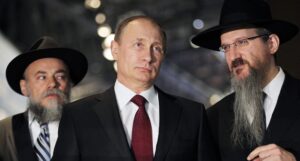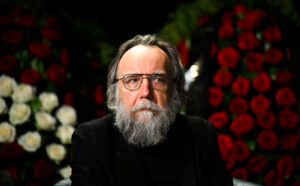During a service this autumn, Patriarch Kirill of Moscow wished a happy birthday to one of his congregants in the Church of Christ the Saviour. It was no ordinary salutation. Radii Il’kaev, who had just turned 85, was a nuclear physicist who had worked for much of his life in the secretive town of Sarov, the birthplace of the Soviet atomic bomb. Long before it became a centre of nuclear defence, the town had been home to a monastery where one of Russia’s most popular saints — Serafim — had lived and prayed.
The Patriarch used Il’kaev’s birthday to make an extraordinary pronouncement: that Russia’s nuclear arsenal was developed under Serafim’s spiritual protection. “By God’s ineffable Providence,” he said, “these weapons were created in the monastery of St Serafim. Thanks to this strength, Russia has remained independent and free.” His message was clear: not only was this saint Russia’s intercessor, but his patronage sanctioned her ability to destroy humanity.
Decades after Soviet attempts to destroy his cult, Serafim has made a comeback. In the context of Russia’s war in Ukraine, even the President has venerated his relics, while a new battalion has been established in his name. In Serafim, Russia has a saint that crystalises the synthesis of religion and military defence. This mix has returned with full force in Russia, although its roots are deeper than the present conflict. Since the Soviet collapse, according to Dmitry Adamsky, the Church has positioned itself as “one of the main guarantors of Russian national security”. Putin confirmed this position as early as 2007, when he told a journalist based in Sarov that Russia would be protected by both its national confession and nuclear armaments. In 2023, this policy has come to fruition.
Appeals to Serafim during times of war, however, are nothing new. Long before Serafim became Russia’s nuclear saint, Tsar Nicholas II turned to him on the eve of his own military misadventure. But first, Serafim’s sacred image underwent a transformation. Serafim was an ascetic monk, who spent much of his life in solitude in the forests nearby Sarov. He went on to become one of Russia’s most renowned spiritual guides. Streams of pilgrims visited him in Sarov, and he was prized for his ability to heal, read minds, and predict the future. After his death in 1833, his fame kept growing, with pilgrims coming from all over Russia to venerate his relics and swim in the holy spring.
By the end of the 19th century, the cult of Serafim had begun to transform. A new chronicle detailed several prophecies that concerned Russia’s future. Serafim predicted that the imperial family would visit the convent of Diveevo — a community of nuns near Sarov, which he considered a divinely-protected spiritual fortress — during a time of great joy. It would be summertime, and hymns of resurrection would be sung. However, after this time passed, he claimed that Russia would experience great suffering. Crosses would be removed from churches and monasteries destroyed. The Antichrist would come. However, although Sarov would fall, Serafim had instructed the nuns to build ramparts in Diveevo which would protect them. Not only would the convent save Russia, but there she would be reborn.
These prophecies reflected a deeper apocalyptic mood spreading in Russia. By 1900, many looked for signs that the world was about to end. Such fears were driven by the social and political context: urbanisation had created a pervasive sense of alienation; factory conditions and housing were resolutely poor; hunger and cholera persisted. Meanwhile, tensions in the Far East raised the possibility of war. But as a revolutionary crisis deepened, systemic reform remained an illusion.
Nicholas II was determined to rule as an autocrat, and he looked to medieval Muscovy for inspiration. To his mind, Russia’s peasants represented the spirit of the nation, and he hoped to form a direct relationship with them to bolster his rule. He did this by an appeal to traditional Orthodoxy. His decision to canonise Serafim was intended to show that he shared their values — but it was more than just political calculation. Nicholas and his consort had long entertained mystics, of whom Rasputin was just one. They were desperate for a male heir, and after trying various folk remedies, they looked to Sarov and Diveevo to assuage their fears. As Russia stood on the precipice of catastrophe, the convent offered a glimmer of hope that the Tsarist regime might survive come what may.
The canonisation of 1903 appeared to fulfil Serafim’s prediction of a time of joy. Yet it soon became clear that things would not go to plan. The summer Nicholas and Alexandra travelled to Sarov was exceptionally hot, and wildfires had reduced entire villages to cinders. Malnutrition stalked the region. Since not enough barracks had been built, many of the 300,000 pilgrims had to sleep under open cover. Most of them were desperately poor, and among them were the severely disabled and those thought to suffer demonic possession. This was far from the romantic image that Nicholas had of his people.
But the full extent of the canonisation’s failure was only revealed the following year. During their visit to Sarov, Nicholas and Alexandra had swum in the holy spring. Yet when Alexandra gave birth to a male heir, their happiness quickly turned to despair: the Tsarevich had haemophilia. Worse still was Russia’s war with Japan. Soldiers stopped at Sarov and Diveevo before travelling to the Far East. Icons of Serafim were also dispatched to the front. And yet the campaign ended in Russia’s humiliating defeat. Nor did the debacle end there: revolution broke out in 1905, and the Romanovs were confronted with the chilling possibility of regime change. As a result, Serafim’s claim as a national intercessor was severely dented. Nicholas and the Church largely distanced themselves from him.
However, for the cult’s true believers, the Bolshevik seizure of power in 1917 confirmed the crisis that Serafim had prophesised. Sarov was forcibly shut within a decade, its churches and buildings mostly destroyed. The monks were dispersed, executed, and sent to the camps. Serafim’s relics were desecrated. Then, in the wake of Hiroshima and Nagasaki, the Soviet authorities chose Sarov to be the centre of its atomic research. Today, the town remains out of bounds for pilgrims. Diveevo, meanwhile, has charted a different course. While it too was closed after the Revolution, it has become one of Russia’s most popular sites of pilgrimage. At its centrepiece are the relics of Serafim, which were re-discovered in the basement of a Museum of Religion and Atheism in 1991 to great fanfare.
That both the Patriarch and Vladimir Putin have visited Diveevo this year only confirms the saint’s renewed importance to Orthodoxy and the Russian state. After serving a liturgy on the 120th anniversary of Serafim’s canonisation, the Patriarch reminded those gathered of Russia’s strength in the face of adversity. He offered the siege of Leningrad as an example of how, even when Russia has abandoned her faith, God continues to show His favour. This was intended not just to rally the faithful, but to call on Serafim too, just as Russia’s war becomes one of attrition.
Shortly after, Putin made his own pilgrimage to Diveevo. He was filmed walking on the famous ramparts, and in the cathedral he was presented with an icon of Serafim. As the President crossed himself, a bishop entreated him to pray to the saint. For conservative commentators, it was a moment full of rich meaning. Mikhail Tiurenkov, for instance, said “that [Serafim’s] Heavenly intercession was incarnated in our country’s flaming shield is clearly no accident”. Yet although Russia celebrates its nuclear security, it knows that it comes at the cost of certain annihilation if used — not just of Russia’s enemies, but its own people too. The only hope, as Putin suggested in 2018, is that: “We will go to heaven as martyrs, and they will simply drop dead.”
As Putin continues to push Russia to the edge in his war on Ukraine, there is a high chance that the Serafim cult will continue to inform public discourse. Like Nicholas II, Putin has turned to Orthodox tradition as he becomes mired in his own battlefield and seeks to steady the ship. Yet if the experience of Russia’s last Tsar is anything to go by, this celebration of Serafim does not bode well. Indeed, it is perhaps the mark of a desperate man. Not for the first time has Serafim’s divine light gone dark.
Disclaimer
Some of the posts we share are controversial and we do not necessarily agree with them in the whole extend. Sometimes we agree with the content or part of it but we do not agree with the narration or language. Nevertheless we find them somehow interesting, valuable and/or informative or we share them, because we strongly believe in freedom of speech, free press and journalism. We strongly encourage you to have a critical approach to all the content, do your own research and analysis to build your own opinion.
We would be glad to have your feedback.
Source: UnHerd Read the original article here: https://unherd.com/




